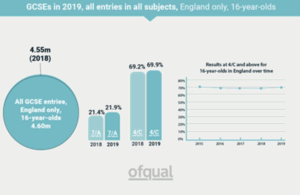Ofqual’s Guide to England’s #GCSEResultsDay2019

Ofqual’s guide to the 2019 GCSE results in England.

Chart showing GCSE entries and results over time
Key points
- The majority of today’s results were awarded for reformed GCSEs, with almost all students in England now only receiving numerical grades.
- Reformed GCSEs were awarded for the first time in 25 more subjects this summer, bringing the total number of reformed subjects to 48. Our focus has been to ensure that standards have been maintained for all qualifications awarded this summer.
- Overall GCSE outcomes at grade 4/C in England have remained stable in recent years and this trend has continued this year (67.1% in 2019 compared with 66.6% in 2018).
- The variability in results at centre level is slightly less than in previous years. Even when there are no changes to qualifications, individual schools and colleges will see variation in their year-on-year results; this is normal.
Today (22 August 2019) we are publishing:
- a summary of this year’s results (below)
- an infographic about this year’s GCSE results
- a report on variability in GCSE results for schools and colleges, 2017 to 2019
- a summary of our monitoring of this year’s GCSE, AS, A level and level 3 project qualifications
- interactive analytics of this year’s GCSE results
- results of the 2019 National Reference Test
Background to GCSE reforms
This summer is the third year that reformed GCSEs graded 9 to 1 have been awarded. Reformed qualifications in 25 subjects were awarded for the first time this summer, bringing the total number of reformed GCSEs to 48. Changes to the GCSEs reflect the government’s intention that the qualifications better prepare students for further study and work, are more stretching for the most able students, and are designed to be accessible to the full range of students who have traditionally taken GCSEs.
The new GCSEs have been phased in over several years. This year over 99% of GCSE entries in England were for reformed GCSEs. By 2020 all GCSEs will be reformed (there are a small number of language GCSEs that will be awarded for the first time as reformed qualifications in 2020).
Setting standards in GCSEs in 2019
We have explained our approach to setting standards in GCSEs this summer in our monitoring report. In the 2019 awards, exam boards used predictions based on students’ prior attainment at key stage 2 to guide the setting of grade boundaries. And, as in previous years, senior examiners have reviewed students’ work in all awards. In some awards, the senior examiners recommended grade boundaries that deviated from those suggested by the statistical evidence. We have not intervened to ask any boards to change their grade boundaries for any of their awards this summer.
This is the first summer that we have considered the evidence from the NRT in awarding GCSE English language and maths. We have published the results of the 2019 NRT and more information about our approach today.
Overall GCSE outcomes
Overall, GCSE outcomes have remained stable in recent years, with only small changes in cumulative percentage outcomes at grade 4/C and above. This is illustrated in the chart below, that shows the overall GCSE outcomes for 16-year-olds in England at grade 4/C and above between 2015 and 2019.
Overall GCSE outcomes for 16-year-olds in England at grade 4/C and above, 2015-2019

GCSE results at grade 4/C and above over time
Grade 9 in reformed GCSE subjects
This summer grade 9 was awarded in the majority of GCSE subjects. Grade 9 is not the same as A*, it is designed to recognise the very highest performing students, so there are fewer grade 9s than there were A*s. Grade 8 straddles the top of the old A and the bottom of the old A*, so there is no direct comparison with A*. We have previously outlined the details of how grade 9 (or grade 9-9 in combined science) is set.
We have looked at the number of 16-year-old students in England taking 7 or more reformed 9 to 1 GCSEs who achieved a grade 9 in all of them. In total, there were 837 students that achieved this, 66% of whom were female and 34% of whom were male. The table below breaks this down by the number of GCSEs taken.
Number of 16-year-old students in England achieving grade 9s in all of their 9 to 1 graded subjects
| GCSEs | Number of students |
|---|---|
| 7 | 78 |
| 8 | 93 |
| 9 | 240 |
| 10 | 293 |
| 11 | 123 |
| 12 | 10 |
Grade boundaries
It is difficult to compare in a meaningful way grade boundaries between reformed and legacy qualifications, for several reasons. Maximum marks for the papers differ, the number of papers in a subject differs, and the type of assessment can be different. It is particularly difficult to compare reformed grade boundaries with those for the legacy qualifications where there was a significant amount of non-exam assessment, or where the proportion of non-exam assessment has changed, since the grade boundaries on written papers may have been higher to compensate for relatively high performance on the coursework. We have therefore only compared grade boundaries with last summer for GCSE subjects that are in phase 1 or 2 of reform, since for these qualifications we are able to compare like-with-like.
The following table shows a summary of the changes in qualification level grade boundaries compared to summer 2018. For specifications where there are optional routes (eg history, religious studies) we have averaged across options within a specification before combining the data across subjects.
Although exam papers are intended to be of the same demand as previous years, in practice, this is very difficult to achieve precisely, so grade boundaries change to take account of the demand of the papers. On average, the grade boundaries at qualification level are higher than last summer by 1 raw mark at grade 7 and by 2.5 raw marks at grade 4. This is what we would expect from our sawtooth research. This research suggests that there is generally a small dip in performance when new qualifications are available for the first time, following which performance gradually improves. Our approach to maintaining standards aims to ensure that students taking reformed GCSEs in the first years are not disadvantaged by being the first to take the new qualifications.
Changes in qualification level raw mark grade boundaries for phase 1 and 2 reformed GCSEs
| Average change (2019 – 2018) | |
|---|---|
| Grade 7 | +1.0 |
| Grade 4 | +2.5 |
GCSE combined science
GCSE combined science was awarded for the second time this summer. This is a double award qualification so is worth 2 GCSEs. It is also tiered, with the higher tier targeted at grades 9-9 to 4-4 and the foundation tier targeted at grades 5-5 to 1-1.There is an allowed (‘safety net’) grade on the higher tier (grade 4-3) that is provisionally set as a half grade-width below the grade 4-4 boundary.
During summer 2018 awarding, exam boards reported to us that there were more students than expected getting an unclassified result on the higher tier of combined science (around 11,000). Exam boards believed that in some cases students should have been entered for the foundation tier. For some students, if they had taken the foundation tier papers, they would have achieved a grade. We therefore exceptionally allowed exam boards to award a grade 3-3 on the higher tier and a full width grade 4-3 boundary. We estimated that this change affected around 9,000 students.
Ahead of this summer, we wrote to all schools and colleges to emphasise that the arrangements in summer 2018 were exceptional and that they would not be repeated in summer 2019. Exam boards also contacted those schools and colleges that were affected in 2018 to support them in making tier entries ahead of this summer. We wanted schools and colleges to reflect on their tier entry decisions in 2018 when making entries for summer 2019.
Exam boards set the grade 4-3 boundaries as expected as a half grade-width this summer for combined science. During awarding, we reviewed data with exam boards showing the number of higher tier students that would be ungraded on combined science with a half-width grade 4-3. For each specification, the percentage of students was significantly lower than before our intervention in summer 2018, suggesting that most schools and colleges had responded to the advice provided by exam boards and us, and adjusted their tier entries.
Just under 4,500 students were ungraded on the higher tier this year, out of a total entry of over 140,000. This is significantly less than the 11,000 students that would have been ungraded in summer 2018 if no action had been taken. Alongside the exam boards, we will continue to consider how we can support schools in making appropriate tier entry choices ahead of summer 2020.
Post-16 outcomes in English language and maths
There has been a small increase in post-16 entries for GCSE English language (from 148,894 to 151,752) and maths (from 160,519 to 169,402) this summer. The table below shows the cumulative percentage outcomes for 17-year-olds, 18-year-olds, and students aged 19+ for English language and maths this summer compared to 2018 (these outcomes are based on data supplied to Ofqual by the exam boards on or before 14 August – while the data is not quite complete, any missing data is likely to be missing at random).
Post-16 outcomes in English language and mathematics
| Subject | Age | 7 and above, 2018 | 7 and above, 2019 | 4 and above, 2018 | 4 and above, 2019 |
|---|---|---|---|---|---|
| English language | 17-year-olds | 1.2 | 1.2 | 32.0 | 30.5 |
| English language | 18-year-olds | 0.5 | 0.4 | 27.7 | 23.9 |
| English language | 19+ | 2.7 | 2.2 | 39.8 | 36.5 |
| Mathematics | 17-year-olds | 1.5 | 1.3 | 22.3 | 21.5 |
| Mathematics | 18-year-olds | 0.3 | 0.3 | 14.3 | 13.4 |
| Mathematics | 19+ | 1.8 | 1.7 | 29.7 | 28.1 |












Responses